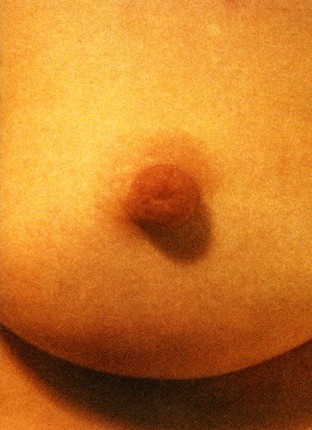
Yoko Ono, Anton’s memory Palazzetto Tito, Fondazione Bevilacqua La Masa
Venezia 29 maggio – 20 settembre 2009
Alcuni visitatori delle mostre di Arte Contemporanea a Venezia saranno rimasti sorpresi dalla circolazione di alcuni gadget (soprattutto shopper) che riportavano l’immagine che Yoko Ono aveva scelto come guida per comunicare la sua esposizione alla Fondazione Bevilacqua La Masa: un’unica mammella umana. Ne parla nel catalogo Angela Vettese, Presidente della Fondazione Bevilacqua:
“È il neonato che vede una mammella sola alla volta e che non è in grado di riconoscerle come coppia. Il rapporto con il nutrimento, con la madre, con la famiglia, con il mondo inizia con la visione desiderante di una mammella unica. La psicoanalisi di Melanie Klein ci racconta come ogni neonato allucini che il seno mancante, il “seno cattivo”, quello che fa percepire fame al neonato, sia in effetti una parte di sé che il bambino stesso teme di aver distrutto quando ancora non riesce a concepire che esso faccia parte di un altro corpo e che, in generale, esistano altri corpi al di fuori del suo: di qui l’origine di una posizione depressiva e spesso auto ed etero aggressiva che può durare tutta la vita. Il bambino dapprima e poi l’adulto sarebbe tormentato da un pensiero mai chiaramente espresso, ma traducibile più o meno così: “lo ho distrutto la parte buona di me”. L’allieva principale di Melanie Klein, Anna Segai, propone come qualsiasi atto creativo possa rappresentare una via verso il ritrovamento del seno e dunque anche del sé: attraverso una ricostruzione del “seno buono”, quello che c’è, che nutre, che da latte, l’arte diventa allora una via di uscita dal desiderio di punirsi e di lasciarsi morire.”
Some visitors of exhibitions of art in Venice have been amazed from the circulation of some gadgets (above all shopper) with the image that Yoko Ono chose as a guide in order to communicate the sense behind this exhibition by the Foundation Bevilacqua La Masa: a single human breast. Angela Vettese, President of the Foundation, writes in the catalogue:
“The newborn baby sees only one breast at a time and is not able to recognise them as a pair. The relationship with food, with the mother, with the family and with the world starts with the yearning for a single breast. Melanie Klein’s psychoanalysis tells us how every newborn hallucinates that the missing breast, the “bad breast”, the one that makes the newborn perceive hunger, is in actual fact a part of him/herself that the child fears to have destroyed when s/he is still unable to conceive that it is part of another body and that, in general, there may exist other bodies outside his/her own: this is the origin of a depressive and often auto/hetero-aggressive position that may last one’s entire life. Initially the child and then the adult would appear to be tormented by a thought which is never expressed in clear terms, yet which may be translated more or less as: “I have destroyed the good part of myself”. Melanie Klein’s main pupil, Anna Segal, suggests how any creative act may rep-resent a path towards the rediscovery of the breast and thus also of the self. Through a reconstruction of the “good breast”, the one that is there, that feeds, that gives milk, art thus becomes a means by which to rid oneself of the desire for self punishment and to let oneself die.”
